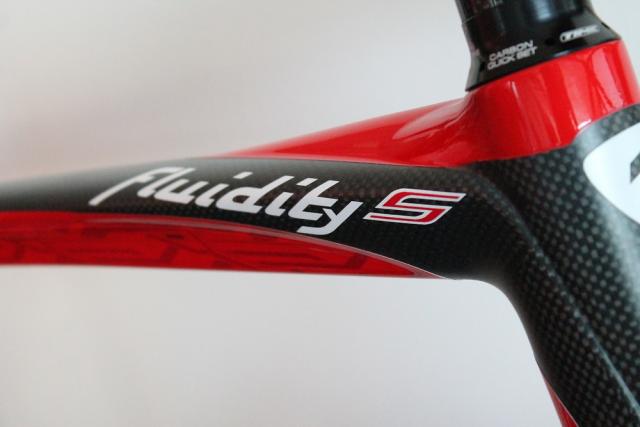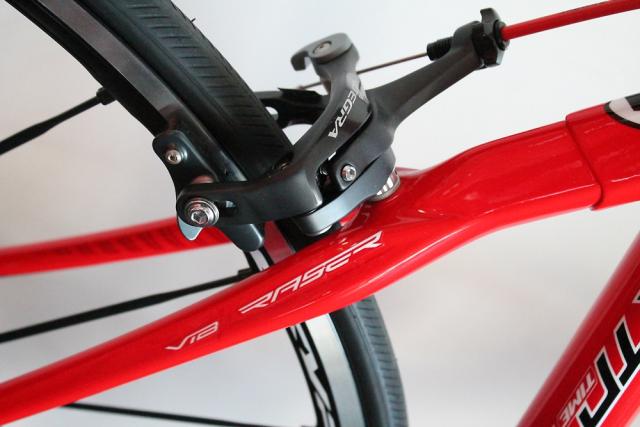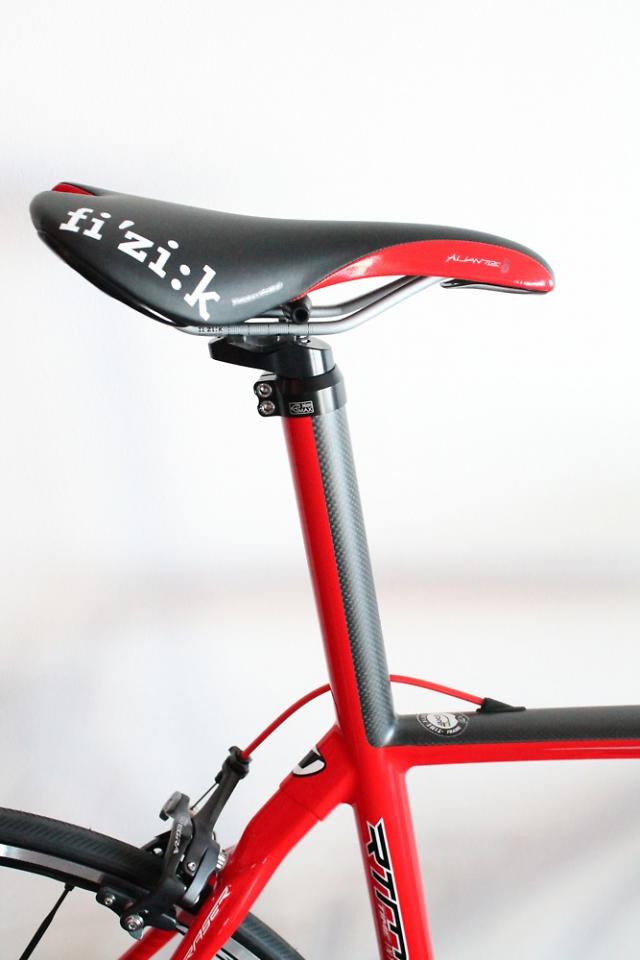- News
- Reviews
- Bikes
- Accessories
- Accessories - misc
- Computer mounts
- Bags
- Bar ends
- Bike bags & cases
- Bottle cages
- Bottles
- Cameras
- Car racks
- Child seats
- Computers
- Glasses
- GPS units
- Helmets
- Lights - front
- Lights - rear
- Lights - sets
- Locks
- Mirrors
- Mudguards
- Racks
- Pumps & CO2 inflators
- Puncture kits
- Reflectives
- Smart watches
- Stands and racks
- Trailers
- Clothing
- Components
- Bar tape & grips
- Bottom brackets
- Brake & gear cables
- Brake & STI levers
- Brake pads & spares
- Brakes
- Cassettes & freewheels
- Chains
- Chainsets & chainrings
- Derailleurs - front
- Derailleurs - rear
- Forks
- Gear levers & shifters
- Groupsets
- Handlebars & extensions
- Headsets
- Hubs
- Inner tubes
- Pedals
- Quick releases & skewers
- Saddles
- Seatposts
- Stems
- Wheels
- Tyres
- Health, fitness and nutrition
- Tools and workshop
- Miscellaneous
- Buyers Guides
- Features
- Forum
- Recommends
- Podcast
TECH NEWS
First Ride: Time’s Fluidity bikes
Time’s Fluidity bikes are designed to combine performance and comfort and, having ridden the VRS Fluidity model this week, I can tell you that they do it very successfully.
The Fluidity bikes are built to what Time call their ‘Performance’ geometry, which is actually what a lot of other brands would refer to as an ‘endurance’ or a ‘sportive’ geometry. So, for example, the medium sized model with a 55.5cm effective top tube comes with an 18.4cm head tube. That means you get a higher front end than with a typical race setup, although it’s not as tall as you get with something like a Specialized Roubaix. Time’s RXRS Ulteam, for example, comes in a racing geometry and a medium sized model has a head tube that’s 1.8cm shorter than the Fluidity’s, and an effective top tube that’s 0.5cm longer – so the difference is significant although not massive.

The idea, of course, is to increase comfort. It’s a little easier to get down to the handlebars, the slightly higher, less stretched ride position taking some of the strain off your back.
Truth be told, the front end felt too high for me, but that’s an individual preference. I prefer to stretch out, get my head down and sod the consequences to my back’s long-term health. Old school. So this setup isn’t the one I’d choose personally, but it’s a perfectly sound arrangement if you want something that’s a touch more relaxed than a traditional racy geometry without going completely sit-up-and-beg.

The other way that Time add comfort is through the material composition. I wrote a short feature on road.cc the other day about how Time make their frames. It’s a really interesting process. Rather than using sheets of pre-preg carbon, they weave the tubes of carbon themselves in their own facility in Lyon.
Things like the angle of the fibres relative to one another and the number of layers used allow Time to control the characteristics of the frame. They can also add other materials to affect the performance. They use aramide (Kevlar) to reinforce areas like the fork steerer, and they also use Vectran.

According to its manufacturer, Vectran is “a high-performance multifilament yarn spun from liquid crystal polymer.” Time use it because it’s strong and it dampens vibration.
The Fluidity frame gets a layer of Vectran added in the down tube, the top tube and the fork. Time call these Vibraser tubes. The Fluidity S (the red bike, pictured) and the VRS Fluidity get two layers of Vibran in their Vibraser Max tubes (the difference between those two models, by the way, is that the Fluidity S has internal brake cable routing and comes in different finishes. The technology is the same).

If that sounds like a load of old marketing guff to you, fair enough, there’s a lot of it about to fool the unwary and you’re right to be on your guard. But here’s the thing: the VRS Fluidity is one super-smooth bike.
It’s hard to describe how the bike feels. It doesn’t really feel like titanium or steel. It feels like carbon still but with a marked lack of vibration… which is the whole idea. It feels like lots of bikes feel on a really smooth road, but even when the road is a bit rough.
Now don’t get me wrong, we’re not talking about night and day here. It’s not like riding this bike feels like you’ve all of a sudden got 6in of suspension front and rear. No, it just feels a little bit plusher than normal. A bit less shaking and rattling. Imagine if you were to run for the bus in your smart Sunday best shoes, and then run for the bus in your trainers. It’s that kind of difference.

Like a fair few manufacturers these days, Time use asymmetric chainstays on the Fluidity bikes to take account of the differing forces on either side of the bike, and the curved Performance seatstays are a wishbone design. Both sets of stays are manufactured separately from the front triangle and then bonded in place. They meet at some very neat carbon dropouts that are made using Time’s CMT process (again, see our previous feature for details on that).
The headset bearing seats are full carbon and you get Time’s Quickset headset as part of the frame and fork package (Time don’t offer complete bikes in the UK, although you could obviously get a dealer to build up a frameset to your exact requirements). This is a system that needs no star nut/top cap assembly. Instead, a threaded collar is bonded to the outside of the steerer and you adjust the headset compression via the Quickset cap. It saves a little weight and you can alter the stem position without adjusting the headset.

The Fluidity S and the VRS Fluidity come with integrated seat post systems. Time call this their Translink design. The idea is that it saves a little weight (40g) and improves the transfer of effort. Once cut to length, you have 30mm of adjustment to play with. That’s easily enough to take care of any variations in height if you swap the saddle or pedals. A normal seatpost can be fitted if you ever sell the bike on to someone with a different leg length. The standard Fluidity uses a 31.6mm diameter seatpost.
All three of the Fluidity models are available in both mechanical and electronic versions and come with BB30 standard bottom brackets (BB86 in the case of the Di2 version of the VRS Fluidity). Time quote frame and fork weights of 1,480g to 1,490g.

The Fluidity (above) is priced at £2,200. That’s for the frame, fork, headset and bottle cage. The VRS Fluidity starts at £3,200 and the Fluidity S is from £3,250 (prices vary depending on the finish).
For more info go to www.time-sport.com and www.extrauk.co.uk.
Mat has been in cycling media since 1996, on titles including BikeRadar, Total Bike, Total Mountain Bike, What Mountain Bike and Mountain Biking UK, and he has been editor of 220 Triathlon and Cycling Plus. Mat has been road.cc technical editor for over a decade, testing bikes, fettling the latest kit, and trying out the most up-to-the-minute clothing. He has won his category in Ironman UK 70.3 and finished on the podium in both marathons he has run. Mat is a Cambridge graduate who did a post-grad in magazine journalism, and he is a winner of the Cycling Media Award for Specialist Online Writer. Now over 50, he's riding road and gravel bikes most days for fun and fitness rather than training for competitions.
Latest Comments
- BBB 45 min 2 sec ago
Inhumane system that now will be getting even worse.
- Bungle_52 4 hours 8 min ago
In case anyone missed it in yesterdays blog here are the two pevious articles. The second one contains the testimony from the driver....
- David9694 4 hours 17 min ago
The old role was appointed at the Mayor's pleasure; is in addition to the permanent staff of the Combined Authority. I'm not sure if Adam was an...
- WillPage 5 hours 43 min ago
Nothing says "welcoming environment" like uniformed thugs, umm I mean "security patrols " roaming the area.
- galibiervelo 7 hours 1 min ago
That is class news. Super bikes and vision. Bet there will be no stand at the Taiwan bike show next year! Big luck to all the team
- Destroyer666 7 hours 43 min ago
Pretty clearly stated several times in the text that the issue was not related just to his son. And besides, everybody watching the races could see...
- Rendel Harris 7 hours 59 min ago
All Fizik and Selle Italia saddles (though not all their other products) are made in Italy I believe, and their 3D printed models definitely are.
- chrisonabike 8 hours 25 min ago
If you're not on the road with a car, I bet its driver is much less likely to swerve into your space *. Because you're not "in the way"! (Any...
- mdavidford 8 hours 41 min ago
The problem with this argument, though, is that it's just not true....















Add new comment
2 comments
It is a thing of beauty, yes, but the join between the seatstays and what used to be called the seat cluster looks very chunky and clumsy. Time often seem to do this, leave some ugly chunky joints on an otherwise beautiful frame, which is a shame but maybe there are technical reasons for it?
Also, I wonder why they've opted for a 31.6 seat post in a bike aimed at comfort? The standard thinking is usually 27.2/thinner for comfort, 31.6/thicker for stiffness, isn't it?
that is a thing of beauty!